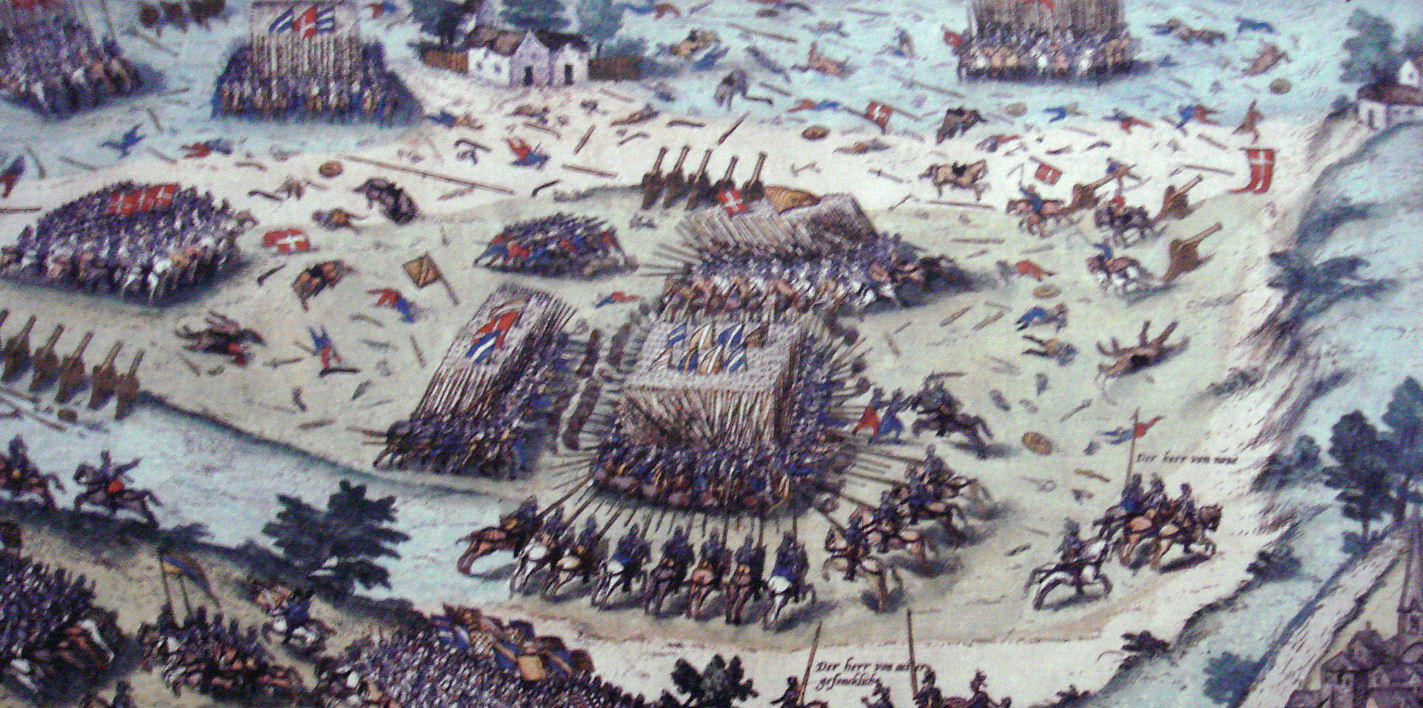Battle Of Yamen - Over 600,000 (initial coalition invasion force of ninety tums approximately two-thirds strong, including Mongols, Chinese, Khitans, Jurchus, Alan Asuds, Turks, Central Asians, Kuan-bo Bai people, and Yi of the Kingdom of Dali)
The Song dynasty's Mongol conquest or Mongol invasion of China, which began under Ugedei Khan (reigned 1229–1241) and ended under Kublai Khan (reigned 1260–1294), was the final step for the Mongols to rule the entire eastern continent. Asia during the reign of the Yuan dynasty (part of the Mongol Empire). It is considered the last great military achievement of the Mongol Empire.
Battle Of Yamen
Before the Mongol–Jin War escalated, a ship from the Chinese Song Dynasty arrived at the Mongol court, probably to negotiate a joint offensive against the Jin Dynasty, with whom the Song had previously fought during the Jin–Sung War. Although Ggis Khan refused, after his death in 1227 he bequeathed a plan to attack the Jin capital by passing through Song territory. Then the Mongol ambassador was killed by the Song governor under unknown circumstances.
Death Toll In Yemen War Reaches 100,000
In the early spring of 1227, Ggis Khan ordered a small army to advance to the Song area of Lizhou (利州路) to attack Jin and Western Xia. The five prefectures of Jie (階), Fg (鳳), Chg (成), He (和) and Tianshui (天水) were destroyed. The Mongols moved south and captured Wuzhou (文州). In July, the Mongols returned to the north. Then Ggis Khan realized that in order to destroy the Jin dynasty, the Mongol army had to use the road through Song. The 1227 Incident (丁亥之變) was the first armed conflict between the Mongols and the Song, but it was a conflict between the Mongols and the Jin.
From the winter of 1230 to the fall of 1231, the Mongols forced their way through the Song dynasty. In this area, through the Three Passes of Shukou (蜀口), they fought a series of battles with the Song army. This was the second and largest armed conflict between them before the official start of the Song Mongol conquest.
In 1233, the Song dynasty finally became an ally of the Mongols, who agreed to share with the Song the territory south of the Yellow River. The Song general Mg Gong defeated the Jin general Wu Xiang and led his army to besiege the city of Caizhou, where the last Zhurch emperor had fled. With the help of the Mongols, the Song army was finally able to destroy the Jin dynasty, which had occupied northern China for more than a century. A year later, the Song generals marched their armies to occupy the old Song capital. They advanced as far as Kaifgu, but were repulsed by a Mongol army led by Tachir, a descendant of Burchu, who was an associate of Ggis Khan.
The Mongol forces, led by the sons of Ugedei Khan, began a slow but steady invasion of the south. The Song forces put up strong resistance, leading to a series of protracted campaigns; however, the main obstacle to pursuing their campaign was the unusual terrain, inhospitable to their horses, new diseases, and the need to wage naval battles, a full form of warfare against the lords of the steppe. The result of this combination was one of the hardest and longest battles of the Mongol conquest.
Amazon.in: Buy The Naval Battle Of Yamen Book Online At Low Prices In India
China put up the fiercest resistance of all the Mongol wars, the Mongols needed every advantage they could get and "every military trick known at the time" to win.
The Koreans and Song offered more "stubborn resistance" to the Mongol invasion than anything else in Eurasia, which was quickly crushed by the Mongols with lightning speed.
The Mongol army that invaded southern China was much larger than the force that was sent to invade the Middle East in 1256.

From 1235, the Mongol general Kuoduan Heqiu began to attack the Sichuan region through the Chgdu Plain. The conquest of these territories was often an important step in the conquest of the south. The important city of Xiangyang, the gateway to the Yangtze Plain, which was defended by the Song general Cao Yu, capitulated in 1236.
File:battle Of Austerlitz 2014 002.jpg
Meanwhile, in the east, Song generals such as Mg Gong and Du Guo put pressure on the Mongol army under Kouw Buhua, as the main Mongol forces were by then moving towards Europe. In Sichuan, Governor Yu Jie accepted the plan of the brothers Ran Jin and Ran Pu to fortify important places in mountainous areas such as Diaouchg (modern Hechuan/Sichuan). From this point on, Yu Jie can hold Sichuan for the next t years. In 1239, Geral Mg defeated the Mongols and captured Xiangyang, competing for Sichuan against the Mongols for many years.
The only permanent conquest for the Mongols was Chgdu in 1241. In the area of the Huai River, the Mongol commanders continued to defend themselves, occupying several major Song cities, although Torege and Gyuyuk Khan ordered their generals to attack the Song.
Many Han defected to the Mongols to fight the Jin. There were 4 Khan Tums, each consisting of 10,000 troops. The four Han generals Zhang Rou, Yan Shi, Shi Tianjie, and Liu Heima commanded the four Han tums under Ogodei Khan.
The conflict between the Mongol-Son troops took place in the Chgdu area. When Törege st voys nya agreed to peace, Song imprisoned them.
Interactive Map Of Yemen War
The Mongols attacked Sichuan in 1242. Their commander ordered the Han Chinese generals Zhang Rou and Chagaan (Tsagaan) to attack Song. When they raided the Song area, the Song court sent a delegation to negotiate a truce. Chagaan and Zhang Rou returned north after the Mongols accepted the terms.
The Mongols used many indigenous ethnic minority soldiers in southern China instead of the Mongols. Kuan-Bo Dali's native army, led by the Duan royal family, made up the majority of the Mongol Yuan army that attacked the Song during the battles on the Yangtze River. During the Mongol advance on Song, there were only 3,000 Mongol cavalry under the Mongol commander Uriyangkhadai, the majority of the army being the local officers of Kuan-Bo and Duan.
The account of the Mongol attack on Nanking is presented in the History of China, which describes how the Chinese defders used gunpowder against the Mongols:

Since the Mongols dug a hole underground where they hid from the shells, we decided to bind them with iron machines called zh tian lei [sky-shaking thunder] ... and lowered them into place.[20]
China And Yemen's Forgotten War
Where the translation of the term tool was by Professor Partington, who described it as an iron pot filled with [huo] yao, meaning 'fire medicine', a low-nitrate gunpowder or proto-gunpowder, sometimes lowered by a chain. , it emits "fire ... from every part," with an incendiary action for many yards that can pierce the metal attached to it, producing "a noise like thunder" that can be heard for miles, resulting in " m and oxen the hides split into fragments (chieh sui) flying in all directions."
Mongol attacks on Southern Song were intensified by the election of Monke as Great Khan in 1251. Passing through the Chgdu Plain in Sichuan, the Mongols conquered the Kingdom of Dali in modern Yunnan in 1253. The Mongols besieged Ho Chiou
And lifted the siege very soon in 1254. Kublai's brother Monke and general Uriyangkhadai conquered Yunnan and Tibet and attacked the Trần dynasty in Vietnam.
Uriyanghadai campaigned successfully in southwestern China and conquered tribes in Tibet before turning east to Dai Viet in 1257.
Gulf States Hold Yemen Talks Despite Boycott By The Houthis
In the autumn of 1257, Uriyanghadai sent three letters to Emperor Dai Viet Tran Thai Tong demanding passage to southern China.
After three consecutive trips to the Dai Viet capital of Thang Long (now Hanoi), Uriyangkhadai attacked the Dai Viet in December 1257 with Geral Trechekdu and Aju.
In October 1257, Monke left for South China and set up his camp near Mount Lupan in May 1258.
According to Đại Việt Sử ký tuến thộ, Mongol forces under Uriyangkhadai fought a large Tran army led by Emperor Tran at Bình Lệ (Bạch Hạc) steppe on January 17, 1258, northwest of Thang Long.
A Clash Of Fleets, A Dynasty's End
Although Chinese sources incorrectly state that Uriyanghadai left Vietnam after nine days due to bad weather,
Uriyanghadai left Thang Long in 1259 to attack the Song dynasty in modern-day Guangxi as part of a coordinated Mongol attack with an invading army in Sichuan under Monk Ke Khan and other Mongol armies attacking modern-day Shandong and Han.
On or about November 17, 1259, Kublai Khan received a messenger during the siege of Ezhou in Hubei describing the advance of the Uriankhadai army from Thanh Long to Tangzhou (now Changsha) in Hunan via Yongzhou (now Nanning) and Guilin in Guangxi.
Uriyanghada's army then pushed north to join Kublai Khan's army north of the Yangtze River on its way back to northern China.
Us Ends Support For Saudi Led War In Yemen
Meanwhile, the Central Southern Song government was unable to withstand the Mongol challenge
Battle of normandy, battle of the cowpens, battle of warships, the battle of gettysburg, battle of cowpens, battle of fredericksburg, battle of brandywine, battle of gettysburg summary, battle of antietam facts, battle of gettysburg map, battle of gettysburg facts, battle of antietam
0 Comments